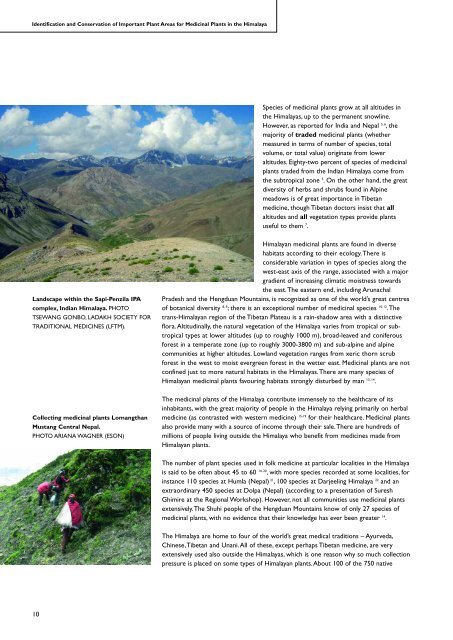Identification and Conservation of Important Plant Areas - Plantlife
Identification and Conservation of Important Plant Areas - Plantlife
Identification and Conservation of Important Plant Areas - Plantlife
- No tags were found...
Create successful ePaper yourself
Turn your PDF publications into a flip-book with our unique Google optimized e-Paper software.
<strong>Identification</strong> <strong>and</strong> <strong>Conservation</strong> <strong>of</strong> <strong>Important</strong> <strong>Plant</strong> <strong>Areas</strong> for Medicinal <strong>Plant</strong>s in the HimalayaSpecies <strong>of</strong> medicinal plants grow at all altitudes inthe Himalayas, up to the permanent snowline.However, as reported for India <strong>and</strong> Nepal 5, 6 , themajority <strong>of</strong> traded medicinal plants (whethermeasured in terms <strong>of</strong> number <strong>of</strong> species, totalvolume, or total value) originate from loweraltitudes. Eighty-two percent <strong>of</strong> species <strong>of</strong> medicinalplants traded from the Indian Himalaya come fromthe subtropical zone 5 . On the other h<strong>and</strong>, the greatdiversity <strong>of</strong> herbs <strong>and</strong> shrubs found in Alpinemeadows is <strong>of</strong> great importance in Tibetanmedicine, though Tibetan doctors insist that allaltitudes <strong>and</strong> all vegetation types provide plantsuseful to them 7 .L<strong>and</strong>scape within the Sapi-Penzila IPAcomplex, Indian Himalaya. PHOTOTSEWANG GONBO, LADAKH SOCIETY FORTRADITIONAL MEDICINES (LFTM).Himalayan medicinal plants are found in diversehabitats according to their ecology.There isconsiderable variation in types <strong>of</strong> species along thewest-east axis <strong>of</strong> the range, associated with a majorgradient <strong>of</strong> increasing climatic moistness towardsthe east.The eastern end, including ArunachalPradesh <strong>and</strong> the Hengduan Mountains, is recognized as one <strong>of</strong> the world’s great centres<strong>of</strong> botanical diversity 8, 9 ; there is an exceptional number <strong>of</strong> medicinal species 10-12 .Thetrans-Himalayan region <strong>of</strong> the Tibetan Plateau is a rain-shadow area with a distinctiveflora.Altitudinally, the natural vegetation <strong>of</strong> the Himalaya varies from tropical or subtropicaltypes at lower altitudes (up to roughly 1000 m), broad-leaved <strong>and</strong> coniferousforest in a temperate zone (up to roughly 3000-3800 m) <strong>and</strong> sub-alpine <strong>and</strong> alpinecommunities at higher altitudes. Lowl<strong>and</strong> vegetation ranges from xeric thorn scrubforest in the west to moist evergreen forest in the wetter east. Medicinal plants are notconfined just to more natural habitats in the Himalayas.There are many species <strong>of</strong>Himalayan medicinal plants favouring habitats strongly disturbed by man 13, 14 .Collecting medicinal plants LomangthanMustang Central Nepal.PHOTO ARIANA WAGNER (ESON)The medicinal plants <strong>of</strong> the Himalaya contribute immensely to the healthcare <strong>of</strong> itsinhabitants, with the great majority <strong>of</strong> people in the Himalaya relying primarily on herbalmedicine (as contrasted with western medicine) 15-19 for their healthcare. Medicinal plantsalso provide many with a source <strong>of</strong> income through their sale.There are hundreds <strong>of</strong>millions <strong>of</strong> people living outside the Himalaya who benefit from medicines made fromHimalayan plants.The number <strong>of</strong> plant species used in folk medicine at particular localities in the Himalayais said to be <strong>of</strong>ten about 45 to 60 14, 20 , with more species recorded at some localities, forinstance 110 species at Humla (Nepal) 21 , 100 species at Darjeeling Himalaya 22 <strong>and</strong> anextraordinary 450 species at Dolpa (Nepal) (according to a presentation <strong>of</strong> SureshGhimire at the Regional Workshop). However, not all communities use medicinal plantsextensively.The Shuhi people <strong>of</strong> the Hengduan Mountains know <strong>of</strong> only 27 species <strong>of</strong>medicinal plants, with no evidence that their knowledge has ever been greater 14 .The Himalaya are home to four <strong>of</strong> the world’s great medical traditions – Ayurveda,Chinese,Tibetan <strong>and</strong> Unani.All <strong>of</strong> these, except perhaps Tibetan medicine, are veryextensively used also outside the Himalayas, which is one reason why so much collectionpressure is placed on some types <strong>of</strong> Himalayan plants.About 100 <strong>of</strong> the 750 native10
















